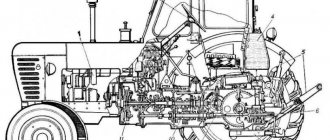In the Soviet Union, gas-powered trucks took over the lion's share of home front work during the war.
Today, wood-burning cars, that is, those equipped with a gas generator engine, seem like an anachronism. But perhaps in the future they will be in demand again due to the gradual depletion of hydrocarbon reserves. In other words, for the same reason why “gasgens” in the mid-twentieth century became a real salvation for warring countries. Almost all the gasoline during the war went to tanks, airplanes and military trucks, and in the rear, cars were useful that could be “refueled” with anything - from coal briquettes to pine cones and from pine logs to straw.
Give me gas generators!
What is a gas generator? Roughly speaking, this is a special combustion furnace, the “pipe” of which is connected to a conventional internal combustion engine through a complex system of coolers and filters. Anything can burn in a furnace, almost any organic matter, as long as it produces carbon monoxide, which is then saturated with hydrogen in the coolers.
This mixture is called generator gas, and it can be used instead of gasoline or diesel fuel. Moreover, for this you don’t even need to seriously alter the engine; it is enough to replace only some fundamental parts in it, for example, install a mixer instead of a carburetor, increase the compression ratio. Or you can do without modifications, although in this case the engine power will be noticeably inferior to that which works using gasoline or diesel fuel. The whole question is whether this gasoline and diesel fuel are available and how close.
In the Soviet Union, work on installing gas generators on cars began almost simultaneously with Europe - in 1923. This year, Leningrad professor V.S. received a patent for his own gas generator installation. Naumov is a man who later became one of the most active supporters of the development of this type of fuel. In 1927, a gas generator of his design was installed on an Italian Fiat one-and-a-half-ton truck and they were convinced that the scheme was completely functional. A year later, on Naumov’s initiative, the country’s first run of gas-powered cars was organized. It was attended by the same Fiat and the French Saumua with a lifting capacity of 3.5 tons with a Rex gas generator. Both cars drove along the Leningrad-Moscow route and proved that gas generator engines are quite suitable for mass installation in cars.
In 1934, the Soviet Society for the Promotion of Motorism and Road Improvement “Avtodor”, in honor of its seventh anniversary, organized a new motor rally, in which seven gas-generating cars already participated. The main goal of the action was to test the performance of domestic gas generators. The conditions for this turned out to be the most severe: all the cars drove from Moscow to Leningrad in pouring rain, and back in snow and fog, on icy roads. Everything arrived, which once again confirmed the efficiency and performance of gas generators. A year later, the Soviet government adopted a resolution “On the transfer of the car and tractor fleet involved in timber removal to wood fuel.” The solution was obvious: logging was taking place in hard-to-reach areas, and the cost of delivering regular gasoline there was economically unjustified.
How to do it yourself?
First, make a drawing - it will help to put together an overall picture of how the design of the unit will look externally.
The device must consist of:
- one hundred liter barrels;
- steel can with a tight lid. It would be good if there were additional fasteners on it;
- pipes with walls fifteen centimeters thick;
- fire extinguisher;
- steel sheets;
- parts of a household heating radiator.
Step-by-step manufacturing process:
- Make five holes in the top of the pipe, weld an oxygen tube to one of them. The rest serve to release gas.
- Weld a perforated stainless bottom at the bottom - this will be the grate part for the coals, and inside there will be a metal cone for feeding the latter. Then complete the structure with a sheet of metal with a hole the size of which is equal to the diameter of the pipe. This will be used as the bottom of the bunker.
- Place the workpiece in a barrel and weld it so that there is an area at the bottom for the remainder of mineral impurities. The can neck should be located above the barrel. Any hole in the latter is connected to the combustion chamber using a tube that supplies oxygen.
- Weld a sheet of metal on top to cover the difference in size of the neck of both the barrel and the can.
Making a gas generator car using wood with your own hands is not as easy as you might think at first. The procedure will require a lot of time and effort. If you are a capable master, ready to experiment and not afraid of difficulties, then this is quite possible to do. Before manufacturing, do not forget to study how the device works and draw up a drawing correctly.
First serial
The clearer the thunder of an inevitable new world war became, the more attention the gas generator topic received in the USSR. On February 28, 1938, a special resolution of the Council of People's Commissars appeared on the production of gas-generating tractors and cars in 1938-1940. And in July, another, but much larger-scale gas generator rally started along the route Moscow – Penza – Kuibyshev – Kazan – Ufa – Magnitogorsk – Chelyabinsk – Omsk – Petropavlovsk – Sverdlovsk – Perm – Kirov – Gorky – Yaroslavl – Vologda – Leningrad – Pskov – Vitebsk – Minsk – Gomel – Chernigov – Kiev – Kursk – Orel – Tula – Moscow. 17 cars took part in it, including 12 with gas generators (six ZISs, five GAZ-AAs and one ZIS-8) and five with conventional gasoline engines. Moreover, the “gasgens” were powered by both wood and coal, and in some places even straw briquettes! In 58 days they covered almost 11 thousand kilometers and reached the finish line without accidents or serious breakdowns. This served as an excellent advertisement for gas-generating cars, the abilities of which could no longer be doubted.
The ZIS-5 and GAZ-AA trucks with gas generator units that participated in the run were no longer prototypes, but completely serial products. Gas generator ZISs (model ZIS-13) began to be produced in Moscow back in 1936. The basis for it was an extended version of the classic ZIS-5 - the so-called ZIS-14, the demand for which was much lower than for the “five”. A gas generator model by Alexander Peltzer (brother of the famous actress Tatyana Peltzer) was installed on it, and the result was a car that could run on wood. In two years, only 900 cars were assembled, and then a much more famous model, the ZIS-21, appeared on the assembly line. It was the same ZIS-5, but with a NATI-G14 gas generator, which was produced by the capital.
Natural gas trucks had several features that made them less convenient than basic gasoline models. Due to the placement of the gas generator unit behind the cab, the body was reduced, which led to a decrease in carrying capacity. In addition, the main column of the gas generator was placed on the right, on the side of the passenger door, and this door, at best, became one and a half times narrower, or was even removed altogether, and the passenger had to make his way to his seat from the driver’s side. And the average speed of the “gasgens” was a quarter, or even a third lower than that of the base model. Still, these cars were in great demand, especially in remote areas where it was difficult to deliver gasoline, but where there was always plenty of wood. Therefore, the ZIS-21 was produced in a large series: until the fall of 1941, until the plant was evacuated to Ulyanovsk and Miass, 15,445 copies were assembled in Moscow.
It was these vehicles that bore the lion's share of the hard work in the distant rear when their gasoline-powered counterparts began to be “conscripted” into the active army. As before, they worked in logging, and in addition took on a significant amount of logistics transportation. And not only the rear ones: for example, in besieged Leningrad, which was experiencing a shortage of gasoline, they were used by both civil authorities and the military, and even many gas-generating cars drove along the Road of Life.
These were not only Moscow ZIS-21s. Since 1939, the Gorky Automobile Plant began producing its own gas generator model, the GAZ-42. This vehicle was inferior to the classic “one and a half” in both load capacity (1.2 tons) and speed (maximum 50 km/h), but suffered the same losses compared to the base model and the ZIS-21. But these cars could be “refueled” with almost anything, although first of all the same pine wood was used. In addition to this, as it turned out, oak, birch, beech and ash firewood was very suitable - the main thing was that it was dry and free of rot. Cones, sawdust, bark, straw, and peat were also suitable, which before use only needed to be pressed into easy-to-use briquettes.
True, gas-generating vehicles required refueling very often, almost every 60-80 kilometers, and the supply of solid fuel taken with them took up a significant part of the space in the body. But it still made it possible to save gasoline, which was so needed at the front. In addition, beyond the Urals, on well-worn roads, they came up with their own way to get rid of the supply of lumps. They simply began to put them in special woodpiles on the sides of the knurled tracks. Each such “refueling” occurred precisely within those same fifty kilometers; By the way, they can still sometimes be found in remote places in Siberia and the Far East.
After the war
Back on November 30, 1941, the State Defense Committee ordered the creation of a new engine plant on the basis of aircraft bomb plant No. 316. This is how the Miass enterprise appeared, which began producing automobile power units, as well as transmissions for tanks.
The speed with which the workers worked is impressive - already on March 16, 1942, a piston ring for the ZiS-5 engine was created. A month later the gearbox appeared. Two weeks later the Zisov engine itself was born. In total, in 1942 the plant produced more than 9 thousand power units and over 15 thousand boxes.
But this was not the only thing the plant was busy with. Since February 1942, the design and experimental department, headed by engineer A.S., began its painstaking work there. Eisenberg.
At first, the KEO was solely responsible for documentation, but the situation changed dramatically after the end of the war. The country felt a gasoline famine. There was a serious shortage of liquid fuel that had to be eliminated somehow. Therefore, many Soviet automobile enterprises took up the development of gas generator technology.
The main burden fell on the Ural Automobile Plant, which, at the command of the People's Commissariat, became the leading plant for the production of gas-generating vehicles based on the ZiS-5. This decision was made in November 1946.
Post-war "gasgens"
Production of the GAZ-42 was completed in 1946, producing a total of 33,840 vehicles. And in the same year, the assembly of ZIS-21 gas generators was resumed at the Miass Ural Automobile Plant named after Stalin - UralAZ. The famous “Zakhar Ivanych”, a military modification of the ZIS-5V, was taken as the basis, so the Ural model began to be called the ZIS-21A (although in the documents of the plant itself it was often listed under the previous “Moscow” index).
It was necessary to organize the production of these machines, since after the Victory the country still experienced a fuel shortage. During the war years, oil production decreased noticeably; for example, in the Baku region alone it fell by half. Many wells in Transcaucasia and the North Caucasus had to be plugged, since there was no time to develop them during the war years, and it was dangerous, plus Transcaucasian oil was simply impossible to export due to the close approach of the front. We must also take into account the following factor: after the war, supplies of petroleum products, primarily aviation fuel, under Lend-Lease quickly ceased, and the developing jet aviation required orders of magnitude larger volumes of fuel.
It was then that gas-generating vehicles, now made in the Urals, came to the rescue again. From 1946 to 1952, UralAZ produced the ZIS-21A model, and 18,620 of these vehicles rolled off the factory assembly line. In the same 1952, this model was replaced by a more modern one - UralZIS-352. Its main feature was a new gas generating unit that could burn wood that was twice as wet as before. If previously lumps with a moisture content of no more than 22% were suitable for gas engines, then fuel with a moisture content of forty percent was also suitable for the UralZIS-352! This was especially true since the main areas where gas-generating vehicles operated were still the North and the Far East.
“Three hundred fifty-second” became the last production gas-generating car in the USSR. Their production ceased in 1956, having collected 15,303 copies. But for at least another ten years, cars with characteristic two columns behind the cab could be found almost throughout the country, and beyond the Urals they were found until the end of the 1970s. The reason was the same as before: delivery of gasoline to remote areas was difficult, and wooden blocks for the gas generator could be cut in the nearest forest.
How the device works
A wood-burning car operates on the principle of a gas generator. The gas mixture is produced using a special unit and sent to the internal combustion engine. When the mixture burns, the car starts moving. If you use such a device, remember that it takes up a lot of space. The on-board design will produce the amount of resources that the machine requires.
True, fuel is considered less efficient, especially if it contains impurities. Because of this, it is first cooled and then cleaned.
When the gas ends up outside the unit, it begins to move through the pipes, heading to the filter and then to the radiator. During the movement, cleaning occurs, as well as a decrease in its temperature. All impurities settle as solid particles and in liquid form on the walls. Using a special tee, the gas is connected with oxygen, and then all this is sent to the engine. Once in the combustion chamber, the gas sets the car in motion.











